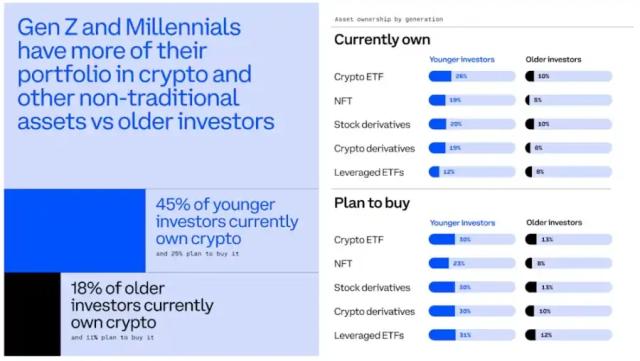Author: Tulip King; Compiled by: Block unicorn
Preface:
The repulsive behavior of @BanklessVC clearly shows that we have entered a predatory, PvP (player-versus-player) market phase. Protect yourself and your gains.
I suspect this cycle has already peaked, and this is a natural pullback, as the crypto market is trying to release the pain - but this pain may last for some time.
Altcoins like virtuals, a16z, and heyanon may set new all-time highs in the recovery, but they will face narrative risks - please continue to re-evaluate your worldview.
What has driven the market rally?
The reason for the market rally is the inflow of new capital into the market, which is obvious. From now on, I will discuss the concept of new capital inflow into the market in connection with the "wealth effect". We should all hope that the crypto industry can create real value (wealth) in the world and share the fruits of monetary expansion. This can be achieved in the following ways:
1. Creating wealth through innovation (airdrops)
Airdrops have become a powerful mechanism for redistributing value in the crypto market, creating a significant wealth effect that benefits a wide range of participants. The Uniswap airdrop in September 2020 set a standard, distributing 400 UNI tokens (worth about $1,400 at the time of issuance) to over 250,000 addresses, ultimately totaling over $900 million.
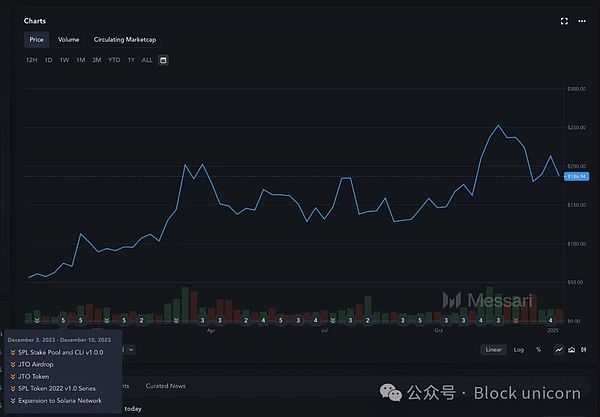 The Jito airdrop was an important catalyst for the early Altcoin bull market on Solana
The Jito airdrop was an important catalyst for the early Altcoin bull market on Solana
The Jito airdrop in December 2023 distributed 90 million JTO tokens, worth a total of $165 million, with some users earning up to $10,000 in returns just by transferring $40 worth of JitoSOL. The Jito airdrop helped drive the growth of Solana's total value locked (TVL) and increased on-chain activity. This wealth effect stimulated broader adoption and development of the Solana ecosystem, similar to how the UNI token catalyzed the growth of DeFi.
Jupiter's token distribution further demonstrates the democratizing potential of airdrops. They plan to distribute 700 million JUP tokens, covering over 2.3 million eligible wallets, which will be one of the most widespread airdrops in crypto history. Jupiter's airdrop strategy aims to promote the growth of its ecosystem by incentivizing long-term participation and governance engagement. These airdrops have shown remarkable efficiency in expanding market participation.
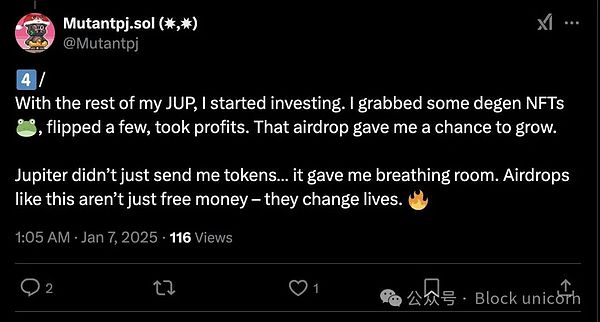 That's what I wanted to say
That's what I wanted to say
The wealth effect is not limited to direct economic gains. These airdrops have transformed users into stakeholders, enabling them to participate in governance and protocol development. This mechanism creates a virtuous cycle: the benefiting participants reinvest their wealth back into the ecosystem, further driving market expansion and innovation.
These strategic distributions have proven to be powerful market catalysts, triggering broader bull cycles in their respective domains. Uniswap's airdrop ignited the DeFi summer of 2020, with its distribution sparking a wave of innovation in decentralized finance. Similarly, Jito's airdrop in December 2023 was a turning point for the Solana ecosystem, driving TVL growth and catalyzing unprecedented on-chain activity. This surge in liquidity and market confidence laid the foundation for the subsequent Altcoin explosion, leading to significant growth. These airdrops have effectively acted as economic stimuli for the entire ecosystems, creating self-reinforcing cycles of investment and innovation that have defined their respective market eras.
2. Appreciation of wealth (marginal buyers)
When the market experiences positive catalysts like strategic airdrops, it attracts previously observing participants, who bring new capital and enthusiasm. The influx of these marginal buyers creates a virtuous cycle of market expansion and innovation.
 Airdrops have triggered positive FOMO, driving deeper participation from new and existing users
Airdrops have triggered positive FOMO, driving deeper participation from new and existing users
Observing investors, after witnessing successful airdrops and the subsequent market momentum, begin to deploy capital, transitioning from bystanders to active market participants. This shift from cash to crypto assets represents the inflow of genuine new capital into the ecosystem, rather than just transfers between existing participants.
Large financial institutions are increasingly driving this transition, with companies like BlackRock, Fidelity, and Franklin Templeton creating products that bridge traditional finance and digital assets. Their involvement helps legitimize the market and provides more convenient entry points for observing capital to enter. This expansion creates a positive-sum environment, where new participants contribute to the overall market growth.
Unlike a zero-sum trading environment, the market ignited by new participants creates real wealth effects through increased liquidity, enhanced development activity, and broader adoption. This positive feedback loop attracts more observing capital, further driving the growth of the ecosystem.
3. Creating wealth through leverage (multiplier expansion)
Towards the end of a bull market, leverage becomes the primary driver of price appreciation, marking the transition from value creation to value multiplication. As the market enters a price discovery phase, traders increasingly use leverage to amplify their positions, creating a self-reinforcing upward momentum cycle.
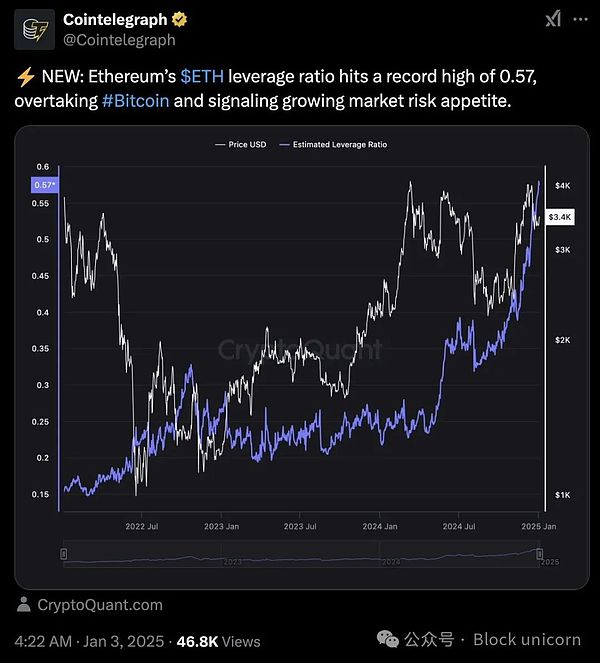 As Bitcoin enters price discovery above historical highs, leverage ratios will spike sharply as traders seek to maximize their risk exposure. This creates a chain reaction, where the borrowed stablecoins drive further purchases, pushing prices higher and encouraging more leveraged positions. This multiplier effect accelerates price volatility.
As Bitcoin enters price discovery above historical highs, leverage ratios will spike sharply as traders seek to maximize their risk exposure. This creates a chain reaction, where the borrowed stablecoins drive further purchases, pushing prices higher and encouraging more leveraged positions. This multiplier effect accelerates price volatility.
The continuous increase in leverage also introduces systemic fragility to the market. As more traders take on leveraged positions, the likelihood of cascading liquidations increases, especially when the cost of borrowing stablecoins becomes more expensive and scarce.
The rise in stablecoin borrowing costs is a key indicator of the market entering its final stage. This represents the transition from organic growth to leverage-driven expansion, where no new value is created - only the amplification of existing value through debt.
At this stage, the severe dependence on leverage creates an unstable situation, where sudden price movements can trigger large-scale liquidations, leading to rapid price corrections. This fragility signals the end of the bull market, as the system becomes increasingly reliant on borrowed capital rather than underlying value creation.
What has caused the market decline?
The market decline is due to the outflow of capital from the market, which is also obvious. This is essentially a reverse wealth effect, where savvy operators design schemes to extract capital from enthusiastic market participants, while the foolish are liquidated.
1. Wealth extraction from the market
The crypto ecosystem periodically experiences cycles of value extraction, where savvy operators design schemes to systematically remove liquidity from the enthusiastic market participants. Unlike the productive innovations that distribute value, these schemes utilize various predatory mechanisms to extract capital from the market.
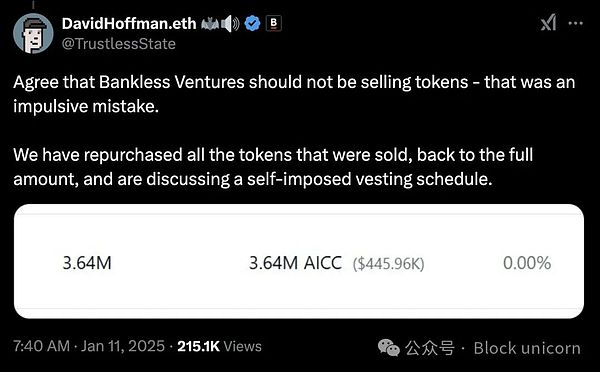 The most repulsive part of the Bankless story is that they consumed thousands of SOL from the ecosystem for just 2 SOL
The most repulsive part of the Bankless story is that they consumed thousands of SOL from the ecosystem for just 2 SOL
The recent launch of the Aiccelerate DAO exemplifies this evolution - despite the support of prominent advisors like the Bankless founders and industry veterans, the project faced immediate backlash as insiders began selling their tokens without any vesting period after receiving them. Even well-known figures can become tools for rapid value extraction.
Celebrity tokens also reflect this predatory behavior. These projects, through malicious smart contracts and coordinated dumping, effectively transfer wealth from retail buyers to insiders, thereby stifling the Altcoin cycle. These extraction events undermine market confidence and suppress the enthusiasm of legitimate participants. They not only fail to establish a sustainable ecosystem, but also create a cycle of distrust, damaging the maturity of the broader cryptocurrency ecosystem.
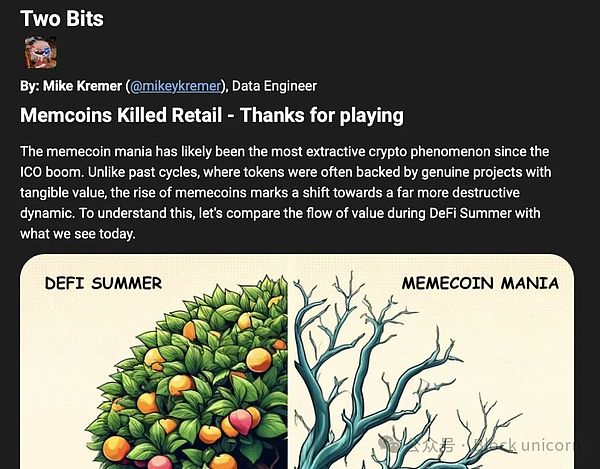 I discussed this issue in a previous Messari newsletter
I discussed this issue in a previous Messari newsletter
These schemes do not reinvest profits back into ecosystem development, but systematically extract liquidity from the market. The extracted funds often completely exit the crypto ecosystem, reducing the total available capital for legitimate projects and innovation.
The evolution from obvious scams to complex operations backed by well-known figures represents a concerning trend. As established institutions engage in rapid value extraction, market participants find it increasingly difficult to distinguish legitimate projects from sophisticated fraudulent behavior.
2. Only Sellers
 Were you surprised that BAYC reached the top in just 3 months?
Were you surprised that BAYC reached the top in just 3 months?
As the market begins to decline, a key asymmetry emerges - the gap between sophisticated players who recognize the market shift and the retail investors who still cling to the bullish narrative. At this stage, the market is characterized not by new capital inflows, but by experienced traders systematically extracting liquidity.
Professional traders and investment firms begin to reduce their risk exposure while maintaining public optimism. Venture capital firms quietly liquidate positions through over-the-counter markets and strategic exits, protecting their capital while avoiding market impact. This creates a false sense of stability, even as a significant amount of capital has already exited the system.
Savvy investors start withdrawing liquidity from DeFi protocols and trading venues. This subtle but steady loss of liquidity creates an increasingly fragile market condition, even though the average observer cannot immediately see its impact.
 It seems some smart money is cashing out their chips
It seems some smart money is cashing out their chips
Denial Psychology: While experienced players can profit, retail investors often still believe the downturn is a temporary buying opportunity. This cognitive dissonance is reinforced by the following factors:
Social media echo chambers maintain a bullish narrative
Attachment to unrealized gains in the bull market
Misinterpretation of the "diamond hands" mentality
Most retail investors missed the optimal exit point and continue to hold during the initial decline, trying to rationalize their decisions. As the downtrend becomes evident, significant value has already been lost, panic sets in, and selling pressure intensifies.
The steady withdrawal of professional capital leads to deteriorating market conditions, with each subsequent sell order having an increasingly pronounced impact on prices. The deterioration of market depth is often unnoticed before the potential vulnerabilities are exposed by sharp price swings.
Unlike the positive-sum environment driven by new entrants in the bull market, this stage represents pure value destruction, as capital systematically exits the crypto ecosystem, leaving the remaining participants to bear the mounting losses.
3. Leverage Unwind (Liquidation Cascade)
The final stage of market capitulation reveals the devastating impact of excessive leverage, as Warren Buffett's famous quote states: "It's only when the tide goes out that you discover who's been swimming naked." The most dramatic collapses in the crypto market are a vivid manifestation of this principle.
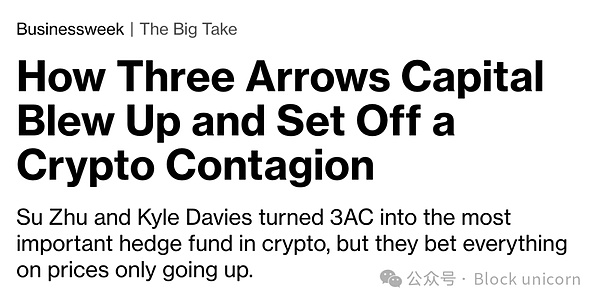
The unraveling began in June 2022 with the collapse of 3AC's $10 billion hedge fund. Their leveraged positions, including $200 million in LUNA and large exposures to the Grayscale Bitcoin Trust, triggered a series of forced liquidations. The fund's failure revealed a complex, interconnected lending network, with over 20 institutions affected by their default.
The FTX collapse further illustrates the dangers of hidden leverage. Alameda Research had borrowed $10 billion in FTX customer funds, creating an unsustainable leveraged structure that ultimately led to the downfall of both entities. Disclosures show that 40% of Alameda's $14.6 billion in assets were held in the illiquid FTT token, exposing the fragility of their leveraged positions.
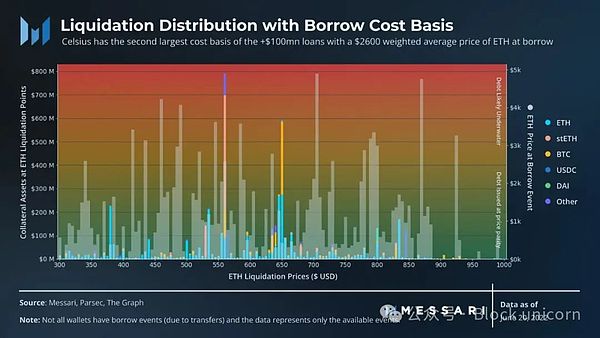 @Saypien_'s old research
@Saypien_'s old research
These collapses triggered widespread market contagion. 3AC's downfall led to the bankruptcy of multiple crypto lending firms, including BlockFi, Voyager, and Celsius. Similarly, the FTX collapse had a domino effect across the industry, with many platforms freezing withdrawals and eventually filing for bankruptcy.
The successive liquidations revealed the true nature of market depth. As leveraged positions were forcibly unwound, asset prices plummeted, triggering further liquidations and creating a vicious cycle. This exposed how much of the market's apparent stability was supported by leverage rather than genuine liquidity.
The receding tide has revealed that many institutions once considered mature were actually swimming naked, with inadequate risk management and excessive leverage. The interconnectedness of these positions means that a single failure can trigger a systemic crisis, exposing the fragility of the entire crypto ecosystem.
Looking Ahead - Narrative Risk
The title of this piece is a bit provocative. My gut tells me this is just a healthy, albeit painful, market cleansing. We will bounce back. Especially since Bitcoin's price targets still seem quite high - but I've already pulled my chips off the table, locking in the Bitcoin gains I'm willing to carry into the next cycle, if this is indeed the end. Remember, no one goes broke taking profits.
I've written many times about the importance of following market narratives rather than clinging to old coins. The longer this market downturn lasts, the more the narratives will shift. If the market fully recovers tomorrow morning, I expect virtuals, ai16z, and virtuals-based tokens to continue winning. But if the market recovery takes longer, you should keep an eye on the new upstarts, see if they can attract new capital inflows.
You should take this as me telling you not to have a coin bias, unless you have a truly strong conviction, don't just hold your coins through the doldrums. Even if they set new all-time highs, I bet you'll miss out on a lot of potential gains by not switching to the new coins in time.
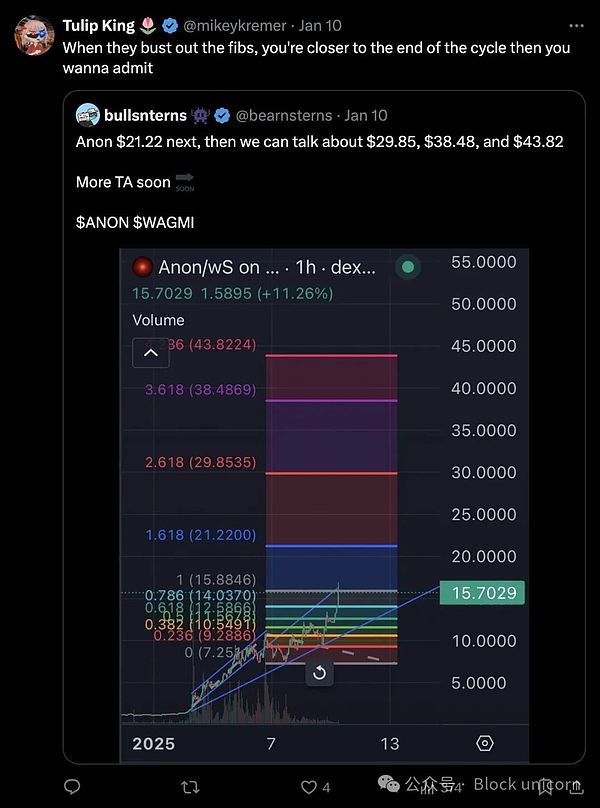 The only reason people post Fibonacci charts is to convince themselves (and others) that they can sell at higher prices.
The only reason people post Fibonacci charts is to convince themselves (and others) that they can sell at higher prices.






